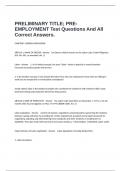PRELIMINARY TITLE; PRE-
EMPLOYMENT Test Questions And All
Correct Answers.
CHAPTER I: GENERAL PROVISIONS
ARTICLE 1: NAME OF DECREE - Answer the Decree shall be known as the Labor Code of the Philippines
(P.D. No. 442, as amended, Art. 1)
Labor - Answer 1. in its limited concept, the term "labor" refers to physical or mental exertion
necessary to produce goods and services
2. in its broader concept, it may include the labor force who are employed or those who are willing to
work but are temporarily or involuntarily unemployed
simply stated, labor is the totality of people who constitute the workforce with whatever skills, trade,
technical training and productive know-how they possess
ARTICLE 2: DATE OF EFFECTIVITY - Answer the Labor Code took effect on November 1, 1974, or six (6)
months after its promulgation on May 17 1974 (LABOR CODE, Art. 2)
Labor Legislation - Answer consists of statutes, regulations and jurisprudence governing the relations
between capital and labor, by providing for certain employment standards and a legal framework for
negotiating, adjusting and administering those standards and other incidents of employment (1
AZUCENA, The Labor Code with Comments and Cases (2016), p. 7) (hereinafter, 1 AZUCENA, Labor Code]
Major Divisions of Labor Legislation - Answer Labor legislation is broadly divided into:
1. Labor Standards
,2. Labor Relations
Major Divisions of Labor Legislation
1. Labor Standards - Answer refers to the terms and conditions of employment that employers must
comply with and to which employees are entitled as a matter of legal right; it deals with the MINIMUM
REQUIREMENTS prescribed by existing laws, rules and regulations relating to wages, hours of work, cost-
of-living allowance, and other monetary and welfare benefits
Major Divisions of Labor Legislation
2. Labor Relations - Answer defines the status, rights, and duties and the institutional mechanisms that
govern the individual and collective interactions of employers, employees, or their representatives
Major Divisions of Labor Legislation
2. Labor Relations - NOTE - Answer Labor Relations laws enable workers to obtain from their employers
more than the minimum benefits set by the labor standards law
Major Divisions of Labor Legislation
NOTE - Answer although the distinction between labor standards and labor relations is useful for
academic purposes, they overlap in reality
for instance, the grievance machinery is a labor relations matter but very often the subject of the
complaint is labor standards such as unpald overtime work or a disciplinary action
Social Legislation - Answer 1. those laws that provide particular kinds of protection or benefits to
society of segments thereof in furtherance of social justice
2. that which requires payment of benefits by government agencies to the worker or his family when and
while he cannot work, by reason of sickness, disability, old age, death, and similar hazards; and
,3. it includes statutes intended to enhance the welfare of the people even when there is no employer-
employee relationship
Labor Legislation v. Social Legislation
As to Effect on Employment - Answer ll: directly affects employment (e.g., wages)
sl: governs the effects of employment (e.g., compensation for injuries)
Labor Legislation v. Social Legislation
As to Purpose - Answer ll: designed to meet the daily needs of workers
sl: involves long-range benefits
Labor Legislation v. Social Legislation
As to Coverage - Answer ll: covers employment for profit or gain
sl: covers employment for profit and non-profit
Labor Legislation v. Social Legislation
As to Effect on Employee - Answer ll: affects the work of employee
sl: affects the life of employee
Labor Legislation v. Social Legislation
, As to Payor - Answer ll: benefits are paid by the worker's employer
sl: benefits are paid by government agencies (e.g. Employee's Compensation Commission)
Labor Legislation v. Social Legislation
Note - Answer labor laws are social legislations but not all social legislations are labor laws
Welfare Legislation - Answer provides for the minimum economic security of the worker and his family
in case of loss of earnings due to death, old age, disability, dismissal, injury or disease
Sources of Labor Laws: (CLIP) - Answer 1. CONSTITUTION;
2. CONTRACT/Collective Bargaining Agreement;
3. COMPANY policies and regulations (China Banking Corp. v. Borromeo)
4. LEGISLATION (Labor Code, Civil Code, and other Special Laws);
5. IMPLEMENTING Rules and Regulations (IRR); and
6. company PAST practices (DOLE PHL, Inc. v. Pawis ng Makabayang Obrero)
Basic Rights of Workers as Guaranteed by the Constitution - Answer 1. Under Labor Standards
2. Under Labor Relations
Basic Rights of Workers as Guaranteed by the Constitution




